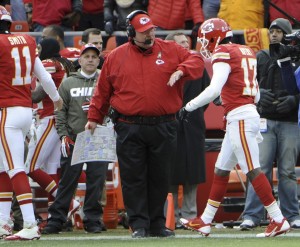KANSAS CITY, Mo. – The Chiefs wide receiver position has been under a microscope in recent weeks given the team’s pursuit of Emmanuel Sanders and interest in DeSean Jackson.

Nov 24, 2013; Kansas City, MO, USA; Kansas City Chiefs wide receiver Donnie Avery (17) is congratulated by coach Andy Reid after catching a touchdown pass against San Diego Chargers at Arrowhead Stadium. Mandatory Credit: John Rieger-USA TODAY Sports
Fueling the attention surrounds a 2013 receiver corps of Dwayne Bowe, Donnie Avery, Dexter McCluster, A.J. Jenkins, Junior Hemingway and Chad Hall combining for 173 receptions for 2,055 yards and 11 touchdowns.
While no Chiefs wide receiver topped 700 yards receiving, the numbers only tell half the story in coach Andy Reid’s version of the West Coast offense.
“What we take a lot of pride in doing is spreading the ball around to all of the different people that we have, and we don’t really focus in on necessarily one person in the throwing game,” Reid said at February’s NFL Scouting Combine. “As a result, that makes defenses have to cover everybody, right?”
Former Philadelphia Eagles wide receiver Todd Pinkston, who played for Reid in Philadelphia (2000-05), echoed his former coach.
“He always wants to spread the ball around, so a team can’t key on one receiver,” Pinkston said in a phone interview. “If you’re doing your job, everything should iron out.”
Reid often discussed that philosophy throughout the 2013 season whenever asked about Bowe’s drop in production. Bowe, who had 57 catches for 673 yards and five touchdowns, posted his second-worst career regular season totals in receptions and receiving yards.
But it’s easy to get caught up in numbers during a pass-heavy modern NFL where game statistics often resemble a video game.
Nevertheless, Reid’s system isn’t designed for a single wide receiver to have gaudy production and the players should know what Reid expects.
“He always preached do your job with what the play is designed to be,” Pinkston said. “Once you get there and make a play, you don’t worry about stats over the course of a game or the course of the year. You just worry about being at the right place at the right time and doing your job.”
Another factor affecting the Chiefs wide receivers corps last season surrounded adjusting to the system. The offense started slow before finding its stride in the second half, and Bowe produced his best game of the year in the playoffs with eight catches for 150 yards and a touchdown.
The second half of 2013 could be a sign of good times ahead. Using himself as an example, Pinkston said the second year is vital to a player’s development in Reid’s system.
“It took me a year and a half to process the whole terminology of the West Coast offense,” Pinkston said. “Once they get that down pat, going into their second season I think everything will improve from there because you want to learn a little bit each year.”
Meanwhile, former Eagles scout John Middlekauff (2010-13) points to Reid’s prior 14 seasons in Philadelphia as a contributing factor to integrate all receivers in the passing game.
“I think early on in Andy’s career in Philadelphia, he dealt with less,” Middlekauff said in a phone interview. “His first really star receiver was Terrell Owens. If he doesn’t have what is a prototypical No. 1, he has no problem spreading the ball around.”
Middlekauff, who currently contributes as an analyst to Comcast SportsNet-Bay Area and co-hosts 95.7 The GAME in San Francisco, brings up a good point on the history of Reid’s receivers in Philadelphia.
Only three wideouts under Reid cracked the 1,000-yard receiving mark: Owens (2004), Kevin Curtis (2007) and DeSean Jackson (2009-10).
Outside of Owens, Curtis and Jackson aren’t the photo image of a big No. 1 wide receiver in the mold of Bowe. But Pinkston, who stood 6-foot-3 and 180 pounds during his playing career, points out size isn’t a prerequisite for Reid’s scheme.
“He’s had big receivers, he’s had small receivers,” Pinkston said. “He had Freddie Mitchell, Greg Lewis, T.O. and myself. There’s no particular height he’s looking for. He’s just looking for a smart receiver that’s going to go out there and give 100 percent every time.”
Middlekauff agreed on the intelligence aspect and categorized Reid’s passing offense as “complicated.” He added the action will dictate a lot of plays.
“You have to be a smart player,” Middlekauff said. “The other thing is you never know when you’re going to get the ball. He runs a lot of three-receiver sets. That’s what he likes to do. You’re going to get a lot of playing time and you’re going to be on the field a lot.”
With McCluster and Hall gone from last year’s roster, Bowe, Avery, Jenkins and Hemingway are joined by Weston Dressler, Frankie Hammond, Jerrell Jackson, Rashad Ross and Fred Williams to compete for playing time.
And the Chiefs will likely draft a receiver if their attempts to land a free-agent receiver are an indication of the team’s desire to bolster depth.
Of course, DeSean Jackson would’ve been an ideal free-agent signing since he has an understanding of Reid’s scheme. A veteran just joining the team not familiar with the offense or a rookie could be at a disadvantage.
“That second year you have to know what you’re doing because he’s going to put everything on the receiver corps,” Pinkston said. “Every player is supposed to know what they’re doing in their second year in the system.”
Still, for any player acclimating or seeking improvement from the prior season, Middlekauff points to a system Reid has in place to assist development.
“One thing he does is he has a lot of carryover on his staff,” Middlekauff said. “David Culley, the wide receivers coach, has been with him forever and Tom Melvin, the tight ends coach. There’s a lot of continuity in the staff in terms of they all speak the same language and they all beat to the same drum, every single one of those guys on offense.”
Ultimately, Middlekauff said he thinks the Chiefs have to draft a wide receiver, while Pinkston said he wouldn’t be surprised if the Chiefs went that route.
But regardless who’s on the roster, Pinkston re-emphasized important factors when it comes to wide receiver success in Reid’s West Coast offense.
“I guarantee you this and I know a lot of former players would agree with me, if he wants a guy, he’ll get a guy,” Pinkston said. “But it takes two years for a player to get used to this system. It’s not about just one guy that should explode. It depends on what the defense presents in the course of a game and how hard the players go to work.”
